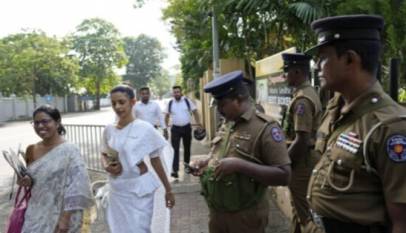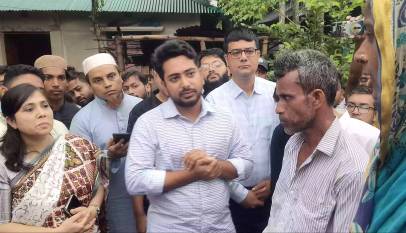Critical Patients in dire need of oxygen support
Staff Correspondent: Medical oxygen supply to public hospitals in at least two divisions has come under severe strain as its demand doubled amid a surge in Covid patients requiring the life-saving gas over the past few weeks.
The crisis of high-flow oxygen support has turned grave at many hospitals in Khulna and Rajshahi divisions. Deaths of patients due to a lack of oxygen support were reported yesterday for the second consecutive day.
At least 13 patients died at two hospitals in Bogura in 24 hours till yesterday noon because of the shortage of high-flow oxygen support provided through a device called high-flow nasal cannula (HFNC).
The devices are meant for the patients whose oxygen saturation levels are very low. But many hospitals in the two divisions don’t have enough devices to treat the rising number of such patients infected with the virus. Of the 13 dead, seven died at Mohammad Ali Hospital and the rest at Shaheed Ziaur Rahman Medical College Hospital (SZMCH), reports our Bogura correspondent.
Besides, at least 10 patients have been battling for their lives at Mohammad Ali Hospital where around 223 Covid patients were under treatment against its capacity of 250 beds.
The hospital has only two high-flow nasal cannula devices, according to Dr ATM Nuruzzaman Sonchoy, superintendent of the hospital.
“There are many patients requiring high-flow oxygen support. We are using over a hundred non-rebreather masks. But the elderly patients are suffering due to the shortage of high flow oxygen support,” Nuruzzaman told yesterday.
A non-rebreather mask is a medical device that helps provide a patient with oxygen in emergencies.
Abdul Wadud, deputy director at the SZMCH, said there were only 12 high-flow nasal cannulas at the hospital where 102 Covid patients were receiving treatment as of yesterday.
A day before, five Covid patients lost their lives at Satkhira Medical College Hospital following a disruption in oxygen supply. The supplier failed to refill the oxygen tank on time, causing a dip in gas pressure.
The surge in Covid infections and deaths over the past few weeks has overwhelmed the healthcare system in several divisions, draining supplies of medical oxygen, vital for critically ill patients.
Health officials said they do not have the capacity to treat every patient in dire need of high-flow oxygen support even if the number of nasal cannulas is increased, as the country is now facing a shortage of medical oxygen.
Officials at the Directorate General of Health Services (DGHS) said the oxygen supply at government hospitals rose to around 200 tonnes a day amid the rise in patients.
Around 100 tonnes of oxygen are required every day to ensure uninterrupted supply at all the government hospitals during normal time, but it shot up to 210 tonnes on Thursday, they said.
Ninety percent of the supply comes from Linde Bangladesh Ltd, a multinational company, while the rest is supplied by Islam Oxygen Ltd and Spectra Oxygen Ltd, they added.
“Till now, we have been able to meet the demand for oxygen. But the way the number of patients requiring oxygen is increasing every day, we will not be able to meet the demand,” Dr Farid Hossain Miah, director of hospitals and clinics at the DGHS, told yesterday.
“We have already sent six high-flow nasal cannulas to Bogura,” he added.
Contacted, Saiqa Mazed, spokesperson for Linde Bangladesh, said, “We are now supplying around 90-100 tonnes of liquid oxygen to the hospitals a day. This is our highest capacity.”
Fuelled by the contagious variant of Sars-Cov-2, known as the Delta variant, the Covid-19 crisis started deepening around two weeks ago. The number of infections and deaths kept rising.
According to a DGHS press release, 132 people died from Covid in 24 hours till 8:00am yesterday, taking the death toll to 14,778.
At least 8,483 new infections were recorded during the period.
The total number of infections stood at 930,042, added the release.
The Covid positivity rate was 28.27 percent yesterday while the overall positivity rate stood at 13.94 percent.
OXYGEN SUPPLY SITUATION
The issue of high-flow oxygen supply at hospitals has been a serious cause for concern since the Covid pandemic hit the country in March last year.
As most of the hospitals across the country had no central oxygen supply system, the government took up multiple projects to set up the system at all district hospitals.
As of yesterday, 56 district hospitals out of 62 had the central oxygen supply system in operation.
However, most of them don’t have adequate numbers of high-flow nasal cannulas.
According to the DGHS, 1,670 beds are equipped with these cannulas at public and private Covid-dedicated hospitals or units across the country. Of those, 843 are in the capital and 59 in Chattogram city.
In Rajshahi division, only 104 hospital beds are equipped with these devices while the number is 304 in Khulna, 54 in Rangpur, 36 in Mymensingh, 56 in Barishal, 21 in Sylhet and 152 in Chattogram.
The crisis of oxygen supply at many hospitals in Khulna division, the new Covid hotspot, is a major cause for concern.
In Khulna city, treatment is being provided to Covid patients at three hospitals. But many patients, who are in need of oxygen support, had to return home after being refused admission to these hospitals.
Yesterday, 379 people were admitted against 320 beds at the three hospitals.
Dr Rashida Sultana, director (health) of Khulna division, believes the division’s treatment facilities are still sufficient to tackle the increasing number of patients.
The division has a total of 304 high-flow nasal cannulas, she claimed.
Sources, however, said it now has 131 active high-flow nasal cannulas.
About the issue, Prof Ridwanur Rahman, an infectious disease specialist, said despite the prime minister’s directives to set up proper oxygen supply system at all district hospitals a year ago, patients are still gasping for oxygen.
“This is gross negligence and a failure on the part of the health ministry,” he told this newspaper yesterday.
“Installation of central oxygen supply system requires at best a week under government arrangements. Importing an oxygen generator is not tough either. But the health officials’ actions did not reflect the urgency,” he noted.
Hospitals started facing a crunch in oxygen supply soon after the second Covid wave hit the country in March this year, pushing up its demand significantly.
The situation turned worse as India imposed a ban on industrial oxygen supply from April 22 to meet its huge demand amid a spike in virus deaths and infections in that country.
Amid heightened demand, the oxygen-producing firms at that time dedicated their production for hospitals treating Covid patients, stopping their supply to industries.
About the shortage of cannulas, DGHS Director Farid said, “The demand for the device was not huge before the pandemic. There was little use of it. Now its demand has risen considerably compared to that a year ago.
“A high-flow nasal cannula requires up to 60 litre oxygen per minute… The problem will not be solved by increasing the number of cannulas unless we enhance our oxygen supply system,” he added.
Rare Israeli airstrike in Beirut kills Hezbollah commander and more than a dozen others
International Desk: Israel launched a rare airstrike that killed a senior Hezbollah milita…







